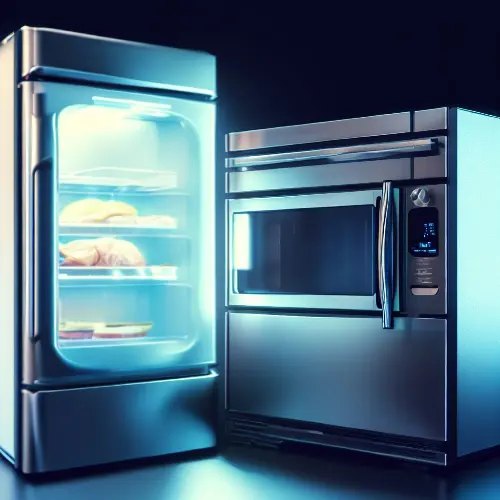Table of Contents
Can a refrigerator and microwave be on the same circuit?
The short answer is yes. When installing or using significant appliances in your home, it’s essential to understand how they connect to your home’s electrical system. Appliances like refrigerators, microwaves, and others require an adequate power supply from your home’s electrical circuits to operate safely and effectively.
But can you connect a fridge and microwave to the same course? Let’s take a closer look.
What is an Electrical Circuit?
An electrical circuit is a closed loop that allows electricity to flow from the main service panel or breaker box to an appliance or outlet and then back again. Most modern homes have 120-volt circuits protected by a circuit breaker or fuse that will trip and cut power if the course is overloaded.
Typical general-use circuits in a kitchen are rated for 15 or 20 amps. The amp rating determines how much total electric load can be connected to the course before it reaches its limit and trips the breaker.
Dedicated Circuits for Appliances
The National Electrical Code (NEC) provides guidelines on how appliances should be connected to household circuits. The NEC recommends placing them on dedicated courses for major appliances like refrigerators, dishwashers, and microwaves – meaning they are the only appliances connected to that circuit.
This prevents overloading the circuit and reduces nuisance tripping of the breaker. It also improves the performance of each appliance.
Can a Refrigerator and Microwave Share a Circuit?
Can you have a refrigerator and microwave on the same circuit? The short answer is yes, and it is possible but could be better. Here are some key considerations:
Electrical Needs of Refrigerators
- Refrigerators need a consistent power supply. The compressor cycles on and off frequently to maintain interior temperatures.
- Most refrigerators draw 5-10 amps while running. Newer models with high-efficiency compressors may use even less.
- Opening/closing the door frequently makes the compressor work harder and draws more power for a short time.
Electrical Needs of Microwaves
- Microwaves require significant power while operating. For example, a mid-size 1200-watt microwave will draw 10-12 amps while cooking.
- This creates a heavy temporary load on the circuit.
Potential Issues with a Shared Circuit
- The combined amp draw of both appliances could overload the circuit during certain use cases.
- Frequent microwave use while the refrigerator is running may trip the circuit breaker, causing both appliances to lose power.
- The refrigerator compressor may not be able to cycle correctly, affecting interior temperatures.
Solutions and Recommendations
- Refrigerators and microwaves should be on separate, dedicated circuits for best performance.
- A 15-amp circuit may work if microwave use is light, but a 20-amp dedicated course is better for each appliance.
- An electrician can add a new circuit easily during new construction or a kitchen remodel.
- A GFCI outlet is recommended for a refrigerator circuit near water sources like an ice maker.
- Keep refrigerators far from heat sources like ovens or dishwashers to reduce strain on the compressor.
Key Factors When Considering Shared Circuits
Here are some other important factors to keep in mind when deciding whether to connect a refrigerator and microwave to the same circuit:
Age of Electrical System
Older homes with outdated wiring may need to be able to support multiple large appliances on one circuit.
Available Amperage
The total combined load of the refrigerator and microwave should be at most 80% of the circuit’s amp rating for safe operation.
Type of Microwave
Smaller, lower-wattage microwaves (e.g., 800W) will draw less amperage and better suit a shared circuit.
Refrigerator Type
New Energy Star-certified refrigerators can operate on just a few amps, allowing more capacity on the circuit.
Frequency of Use
Occasional microwave use creates less demand than daily cooking and reheating.
Other Connected Appliances
Avoid connecting small countertop appliances like a coffee maker to a shared circuit, which adds more demand.
Guidelines from Electricians
Many electricians recommend avoiding sharing a circuit between a refrigerator and a microwave. But some provide the following general guidelines:
- A 20-amp circuit can safely serve a refrigerator and 1000W microwave if usage is moderate.
- Keep the combined load under 16 amps for best results.
- Only connect a 700-900W microwave to a 15-amp circuit shared with a refrigerator.
- Never connect small appliances like coffee or toasters
- to the shared circuit.
- Add GFCI protection to help prevent overloads.
Again, separate dedicated 15 or 20-amp circuits remain the ideal setup for refrigerators and countertop microwaves. But if necessary, a shared course can work if usage is not excessive and wattages are moderate.
FAQs
Can a refrigerator and microwave be on the same circuit?
Yes, a refrigerator and microwave can be on the same circuit, but it depends on the electrical requirements and the capacity of the course.
Do I need a dedicated circuit for my refrigerator and microwave?
It is recommended to have a dedicated circuit for both the refrigerator and microwave to ensure they have enough power and to avoid overloading the circuit.
What is a dedicated circuit?
A dedicated circuit is a circuit that is used solely for one appliance or outlet. It is not shared with any other instruments or outlets.
What is the electrical requirement for a refrigerator?
The electrical requirement for a refrigerator may vary, but most refrigerators require a dedicated 15-amp or 20-amp circuit.
What is the electrical requirement for a microwave?
The electrical requirement for a microwave may vary, but most microwaves require a dedicated 15-amp or 20-amp circuit.
Can a refrigerator and microwave share the same circuit if they both require dedicated courses?
No, if the refrigerator and microwave require dedicated circuits, they should each have separate circuits.
Can a refrigerator and microwave be plugged into the same outlet or receptacle?
Plugging a refrigerator and microwave into the same outlet or receptacle is not recommended. It is best to have them on separate circuits.
Can a refrigerator and microwave cause the circuit to overload?
It is possible for a refrigerator and microwave to cause the circuit to overload if they are on the same course and drawing too much power.
What happens if I plug a refrigerator and microwave into the same circuit?
If you plug a refrigerator and microwave into the same circuit, it can cause the circuit to trip, or the appliances may not receive enough power.
Do kitchen appliances like a refrigerator and microwaves require GFCI protection?
According to the NEC (National Electrical Code), kitchen appliances like refrigerators and microwaves do not typically require GFCI protection.
Key Takeaways
Sharing an electrical circuit between a refrigerator and microwave is possible but could be better. Dedicated courses are recommended for best performance.
Overloading a circuit can lead to nuisance, tripping of breakers, and loss of power.
Microwaves create temporary high demand when cooking while refrigerators cycle continuously.
A 20-amp circuit can serve both appliances if usage is moderate.
Smaller, lower-wattage microwaves are better suited to a shared circuit.
An electrician can advise on the specific electrical needs and help design appropriate circuits during a kitchen remodel.
Proper placement, usage habits and electrical demand monitoring help ensure a shared circuit does not overload.
Conclusion
While running a refrigerator and microwave on the same electrical circuit is not necessarily advised, it may be possible in certain situations if electrical loads are managed carefully. The best practice is following NEC guidelines and placing major kitchen appliances like refrigerators and microwaves on their dedicated circuits with adequate amperage.
But practical factors may dictate circuit sharing in some homes, especially older ones. By understanding proper installation and monitoring usage, overloads can be avoided, and both appliances can coexist successfully on a shared circuit. Consulting an experienced electrician is recommended to further assess your specific needs and wiring situation.

I’m Ian Welkins, a seasoned professional in the kitchen industry. My passion now drives me to provide invaluable insights into the world of top-notch kitchen products. With years of hands-on experience, I’m your go-to source for culinary excellence.











